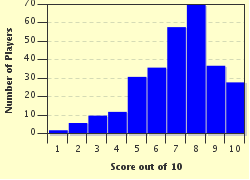Quiz Answer Key and Fun Facts
1. "The end is nigh!" exclaims the Pope. That is certainly enough cause to make everyone listen. Pope Sylvester II supposedly expected the Rapture to occur on a very mathematically significant date in relation to Jesus, the first and seemingly only time the head of the Catholic Church predicted such an occurrence. He called for the end of the world on January 1 of what year?
2. Around the middle of the 14th century, people in Europe and Asia had a very real reason to fear the end of the world. In the span of twenty years, the global population dropped by 75-200 million due to a disease starting in Asia in 1334, and working its way west to the Middle East and Europe. What was this plague, which people were sure was the very vengeance of God?
3. Many people who are not normally considered 'prophets of doom' made their own end of the world prophecies, including a famous explorer. This Italian explorer was a very religious man, who believed he helped spread Christianity to Asia (though he never got there, having gone westward from Europe). Later on in life, he claimed to have discovered the world would end in 1658, 152 years after his eventual death. Who was this?
4. Cotton Mather, a minister in colonial New England, was a deeply religious and quite misguided man. He prophesized the Apocalypse in 1697; once he had lived through that, he revised it to 1716; and before he died, he made a final revision to 1736. These were made because he believed he had personally seen the devil's work, most notably in what 1692 charade?
5. In the early 1840s, William Miller led a movement the world would end on several dates - March 21, 1844; April 18, 1844; and October 22, 1844 - updating each time after the previous prediction failed. He had so convinced his followers that many gave up all of their worldly possessions, and so the aftermath was known by what nickname?
6. Some groups calling for the Apocalypse have no shame in calling for failed date after failed date. One group saw the end coming in 1874, 1878, 1881, 1908, 1914, 1916, 1918, 1920, and 1925 before it finally fractured. Led originally by Charles Taze Russell, it would by 1931 fracture into four distinct religious groups. What movement was this?
7. Five years before building a compound at Jonestown, Guyana, this founder of the People's Temple returned from a visit from Brazil and announced that on July 15, 1967, the world would suffer a nuclear holocaust which open the way to create a socialist Eden. Who was this man, who led his followers to a mass suicide of 909 people in 1978?
8. Beginning in the 1970s, Marshall Applewhite led a group called "Heaven's Gate," which technically did not say the world would end, but rather would be "recycled." Believing our bodies were only vehicles for the soul, Applewhite finally found a way to escape in 1997. He led a mass suicide of his group hoping to ascend to a spacecraft supposedly following what comet?
9. Perhaps the most famous of all "prophets," this man simply wrote "the year 1999, seventh month from the sky will come a great King of Terror," whom most assumed was the Antichrist. Having "correctly predicted" events from the atomic bomb to Princess Diana's death, people wondered if he should be taken seriously. Who was this 16th-century Frenchman?
10. This year was the end-all-be-all of doomsday prophecies. Isaac Newton, Edgar Cayce, and Jonathan Edwards saw Christ returning; Jerry Falwell said "January 1... will be a fateful day in the history of the world"; Ruth Montgomery predicted Earth's poles would shift; and everyone feared of a computer virus that would leave the world powerless. What year was sure to be the last of civilization?
Source: Author
illiniman14
This quiz was reviewed by FunTrivia editor
bloomsby before going online.
Any errors found in FunTrivia content are routinely corrected through our feedback system.

